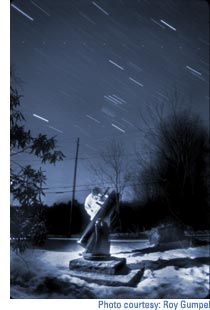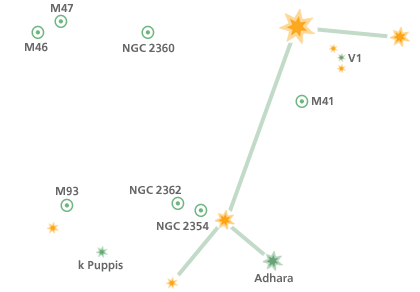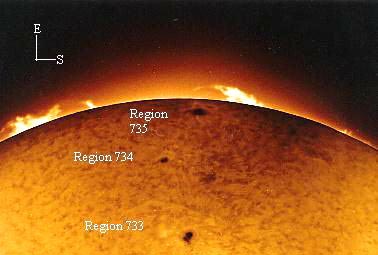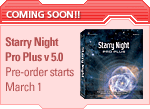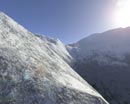 |
||||||||||||||||||||||||||||||||||||||||||||||||||||||||
|
If you have trouble viewing this newsletter, click here.
This was around the time Star Wars first came out and it wasn’t long before I found a better use for the tube assembly. Having suddenly lost interest in astronomy, I did what all the kids were doing in those days: I turned my telescope into a light-saber. I was Darth Vader. The washing-line pole was Luke. It wasn’t long before the lenses fell out. Fifteen years later, I was vacationing in New York State. One night, standing on the edge of the Ashokan Reservoir under clear, dark skies, I looked up and saw the Milky Way for the very first time. Growing up in the sodium-soaked suburbs of Ireland, I’d simply never seen it. I liked it so much I moved there. Now I'm living just few miles south of the Ashokan, and I finally have access to dark skies. I bought the books, subscribed to the mags, learned the constellations, and got on the Internet. After a couple of months of intensive research, I decided on an Orion XT-8. At the time it was the flagship model of a new, well-received line of elegant Newtonian scope. I remember when the boxes arrived. Naturally, it was cloudy. But I set up the base and the OTA anyway and, through the clouds, I was able to make out the disc of Jupiter. That was thrilling — to see it had two dimensions, to see how huge it was: amazing. The XT-8, developed further by Orion over the years, and now accompanied by a 10” big brother, has been a great scope for me. I want particular things from a telescope. The most crucial thing I want is the chance to connect with the sky with as little in the way as possible. The XT-8 has a very simple design: Dobsonian mounted on a smooth lazy-Suzan-like base, it’s basically a chunk of metal with two mirrors that I push around by hand. The lack of Go-To technology means I have to navigate using my entire body: my eyes, my hands, my numb podgy fingers, my legs, my back, my brain. I have to plan ahead before I go out and, when I’m out, I have to think backwards and upside down. I have to deal with frustration. But I enjoy beating the cold, the clouds, the odds. And the result is that I know not just the rough location of objects in the sky, but their exact location. I know how to get to them. Without maps or charts, I can star-hop to the Leo Triplets, to the Pinwheel and Whirlpool Galaxies, to NGC 4565 (that freaky-long galaxy in Coma Berenices), to the Ring Nebula in Lyra, and that I really enjoy the swirl of tiny asterisms on the way to M78. But my favorite all-time use of the scope was a class I gave a while ago to kids at a local school. We did the whole scale-of-the-solar-system thing — each kid holding a grain of rice or an apple and standing 50, 80, 300 paces apart — and we projected the image of the sun onto some white card to see a nice cluster of sunspots. The kids were blown away. Not only had they no idea the sun could be “dark”, but they’d never actually seen a telescope up close. I asked them what they saw in their mind’s eye when they imagined a telescope. They pointed to my XT-8 and said, "Nothing like that!" I thought they’d describe a Galilean type scope, the kind used by pirates: to me, the archetypal telescope. Instead, they described the giant scopes you find in full-blown observatories: in other words, the kinds of scopes they’d seen on television. Explaining that my scope used mirrors to magnify images was great fun; the kids looked down the tube to see their heads enlarged in the primary mirror. A recent purchase was a solar filter. This fits snugly over the open end of the scope’s tube and allows me to look directly at the sun’s surface, without fear of going blind. I keep an eye on sunspot activity via a NASA Web site. The LiveSky pane in Starry Night has a plethora of great links to solar science resources too. When something grabs my attention, I pull out the scope for some daytime sky surfing. Finding planets in the middle of the day is another favorite. The trick is to watch for when the moon comes close to Jupiter or Venus (if it’s very high, away from the sun). That allows you to gauge where you should look. Sweep around slowly with binoculars or your finderscope. Then, once you've found your target, you can put the optical aids to one side and simply point and view. Of course Starry Night is a great help here too, but I don't need to tell you that. Sean O'Dwyer, Starry Night Times Editor
At Mag -1.5, almost everyone knows that Sirius is the brightest star in the night sky. You may notice it driving home from work: visible from early dusk, it sparkles brilliantly above the southern horizon. What many people don't realize is that Sirius is actually a double star. Sirius B is a challenging target, just 5" from Sirius and quite dim at Mag 8.5. It requires excellent optics but, if you can nail it, it's surely a feather in your cap. A little to the west of Sirius is a three star asterism, with the central star, V1, being an easy, pretty double separated by 17". M41 (also known as the Little Beehive) is a fine open cluster lying about 2,000 lightyears from the back of your eyeball. It has about 25 bright stars spattered across a field about the size of a full moon; in reality, they're spread over an area 20 lightyears in width. Bright enough to be sometimes visible to the naked eye (Aristotle is said to have noticed it around 325 B.C.) M41 is a good target for binos or low magnification in your scope. M46 and M47 are two open clusters just over 1° apart, making comparison very easy. Both are about 20 million years old but they're not connected in any way: M46 hangs in space about 5,000 lightyears distant, while M47 is closer at 1,700 lightyears. Of special interest is the planetary nebula that seems to be embedded near M46's center. Although the nebula is probably not actually part of the cluster (it simply lies along the same line of sight), it makes for a good opportunity to see two different types of deep sky object at the same time. In larger scopes, NGC 2360 (a.k.a. Caldwell 58) is a pleasing open cluster almost half way between M46 and Sirius. M93, the winter Butterfly Cluster, is a rich 6th Mag open cluster with about 80 visible stars. It's core resembles an arrowhead. While you're in the area take a look at k Puppis, a nice bright double. NGC 2362, the Mexican Jumping Star (a.k.a. Caldwell 64), and NGC 2354 are another pair of closely placed open clusters worth comparing. Finally, Mag 1.5 Adhara has a Mag 7.5 double just 7.5" due south. Adhara is a main sequence star that shines 9,000 times as brightly as our own sun. Good thing it's 432 lightyears away. Sean O'Dwyer
Filtergram showing regions 733, 734 and 735 This month's winning photo submission is from Monty Leventhal. A Starry Night user, Monty does his imaging from Sydney, Australia. This filtergram taken on the 10th February shows solar active regions 733, 734 and 735. Each region is a large solar storm on the Sun’s surface. The feather-like structures around the limb of the Sun are flares and prominences.
Photo Notes: Filtergram of the Sun, taken February 10th at 21:30 UT from Sydney. Meade 10” SCT telescope. Olympus OM1 with Kodak Tech. Pan film. DayStar H-alpha 6A. PHOTO OF THE MONTH COMPETITION: We would like to invite all Starry Night users to send their quality astronomy photographs to be considered for use in our monthly newsletter. Featured submissions (best of month) will receive a prize of $25 USD. Please read the following guidelines and see the submission e-mail address below.
|
Feb. 2005
|
|||||||||||||||||||||||||||||||||||||||||||||||||||||||
 |
||||||||||||||||||||||||||||||||||||||||||||||||||||||||
|
|
||||||||||||||||||||||||||||||||||||||||||||||||||||||||
